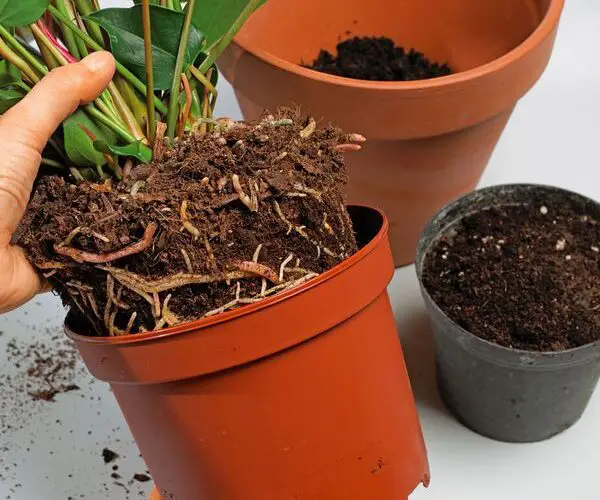When you repot the plant in a larger pot, it tends to grow faster and get bigger. So this is the kind of technique you would want to apply to a fairly young plant, which has not reached its maximum size. For example, when you make stem or leaf cuttings, you do it in small pots.
Then, as the young plant gets bigger, you pot it in a slightly larger pot, and then you pot it in an even larger pot when it starts to overflow from that pot as well. But when the plant finally reaches the size you want, potting it in a larger pot is no longer worth it.
Contents
Can a plant become too big for a pot?
Indeed, if all the favorable conditions are met, it is possible that the plant will evolve towards its maximum genetic potential. Don’t panic, in this case you will just have to repot, but before taking such a decision, you must be sure that the pot has become too small:
How to know when the jar is too small
To find out if the pot is too small, look at the roots of the plant. If they are growing upwards or coming out through the holes in the bottom of the pot, they are in urgent need of space. Sometimes plants need a new pot as soon as they are bought. Before you give it a final location, check if your plant does not need a larger pot.
Repot when the pot becomes too small?
If your plant is skinny, if the leaves turn yellow or fall off, if the roots try to escape through the air hole: it is the right time to consider repotting, it lacks space. Always the same advice, choose a slightly larger pot.
When is the best time to repot a plant that has become too big?
The ideal times are early spring and late summer. In March, for example, the plant enters the growing season after a long period of rest. The return of light and heat reactivates its growth, its roots will need space.
The perfect pot size for plants
Most plants do not like pots that are too big. Water can accumulate in places where the roots can’t reach and this excess moisture can cause them to rot. But a pot that is too small does not provide the space the plant needs to grow.
How to repot a plant in the right way
1. Select and prepare the potting jar
Choose the new pot
– It must be pierced with a hole and of a diameter slightly higher than that of the old pot, without more: suddenly transplanted in a too large pot, your plant would be disoriented.
– If you opt for a new terracotta pot, soak it in water at least one hour in advance.
Prepare the pot
– Cover the drain hole with a pebble or shard from an old broken pot to prevent it from being blocked by roots.
– Place a drainage layer 3 to 4 cm thick at the bottom of the pot: clay balls or gravel. Tip: to prevent the clay balls from mixing with the soil, place a piece of permeable and rot-proof felt, cut to the size of the pot, over the drainage layer.
– Place a few centimetres of new potting soil on top of the drainage layer, choosing a potting soil suitable for the plant.
Choose a pot adapted to the size of the plant.
2. Choosing the right potting soil for the plant
– To repot a green plant, or to repot flowers, you can use a potting soil for green and flowering plants.
– To repot a greasy plant, it is essential to choose a very draining substrate: a special cactus potting soil is perfect.
– To repot an orchid, use a light and airy potting soil: a special orchid potting soil, for example a mixture of bark and peat, is strongly recommended.
3. Remove the plant
Before removing a plant, look for roots coming out of the water drainage hole. If so, cut them off. Then strike the bottom of the pot with a few sharp blows and carefully remove the plant.
The larger the plant and the larger the pot, the more complicated the removal can be. Here is how to remove a large plant:
– Avoid watering the plant before planting, as a dry root ball takes up less volume and is easier to remove.
– Run a long blade between the pot and the root ball, around the entire circumference of the pot.
– If the rootball is still resistant, the only solution is to break the pot with a hammer, or cut it up if it is made of plastic.
4. Repot the houseplant
- Examine the rootball removed from the old pot: if the roots are rolled up, untangle them carefully; if some are damaged or appear diseased, cut them off.
- Place the root ball upright in the center of the pot and gradually pour the new potting soil around it, pressing it lightly with your fingers. When you reach the top of the root ball, pour a little more potting soil on top, stopping about 2 cm from the top of the pot.
- Pack lightly and water copiously in several times.
- If the soil settles too much after watering, add a little more soil.
An Alternative Potting Technique: Surfacing
When the size of a plant and the size of its pot have become very important, repotting becomes complicated. It is then possible to replace partially the substrate without repotting, by resorting to a simple surfacing. This technique is particularly recommended to avoid the repotting of ficus or other tropical plants of important dimensions.
- Using a claw or a small shovel, first remove as much soil as possible from the pot without damaging the roots of the plant.
- Replace the removed substrate with new potting soil.
- Pack lightly and water, just as you would for repotting.
- Repeat this operation every year in early spring.
Summary
To conclude, a plant can become too big for its pot, but this is not something we are used to seeing every day. If this happens, nothing serious, just repot your plant in a slightly larger pot. We have a paragraph in this article about the perfect pot size for plants.








